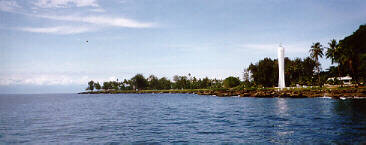|
Michael McFadyen's Scuba Diving - Planet Rock
Madang in Papua New Guinea has some excellent dive sites, both wrecks and reefs. While the wrecks are mostly located inside the protected harbours of Madang, Sek, Mililat and Nagada, the reef diving is all carried out on the reefs in the open ocean. Despite what you might think this may mean for the sea conditions, on all of the 30 or so dives I have done in the Madang area I have never experienced anything but flat, millpond seas. Makes for easy diving, even for those who suffer from sea sickness.
 |
| The Coastwatchers Monument in Madang township |
One of the more special dives here is Planet Rock. Located to the south of Madang township (about 20 minutes run from Jais Aben Resort), you get a picturesque view of Madang Harbour and Madang town as you motor your way up the main shipping channel. As you pass out of the harbour you can see the Coastwatchers Monument (see photo on left). This impressive structure remembers the famous Australian and British men who hid in the jungle of Papua New Guinea during World War 2 and provided invaluable "spy" information to the Allies. Using friendly natives and binoculars, these men took note of all Japanese planes and ships that passed their locations and radioed this onto a central point in Australia or Port Morseby. You soon pass the monument (which doubles as a lighthouse) and speed down the coast before veering out to sea a bit. This dive site is a bit different to the others in the area. Instead of being located on the fringing reef (or the reef straight off the mainland), Planet Rock is a small bommie that rises up from more than 80 metres to a very shallow five metres. It is not real big, perhaps 150 metres by 50 metres at its extremes.
The boats tie up to a mooring at the southern end of the reef and most dives here start by swimming to the south over the edge of the reef. The depth here goes to much more than 80 metres. I have dived this site three times and on my last dive we went down to 60 metres or so in search of sharks but we did not see any at this depth. However, it was quite beautiful down there (even allowing for the effects of nitrogen narcosis!) with huge gorgonia fans, barrel sponges and some excellent soft corals. The visibility here was some of the best I have ever seen, possibly 40 metres but it was a bit dark, especially as the top one metre was extremely dirty freshwater from a huge thunderstorm that hit two days earlier.
We gradually ascended, keeping outside decompression limits. We travelled clockwise around the reef, drifting along in the current for a bit over a half of the dive before swimming into a slight current for the remainder of the dive. This was never a difficult task, as the current can be avoided by keeping close to the reef and using the nooks and crannies of the reef.
Fishlife on parts of Planet Rock was prolific, with large schools of rainbow runners, trevally, surgeonfishes and unicornfishes seen on different parts of the reef. On the way around we also saw a couple of very large hump-headed parrotfish and double-headed Maori wrasse. These were huge fish, up to two metres long in the case of the wrasse. A few blacktip and whitetip sharks were seen in the shallower areas. On my dives here, the best spot for seeing sharks was the southern side of the reef which can be easy at the end of the dive. This whole section of the reef contains magnificent fishlife, including some schools of large military seapike (a species of barracuda).
There are also some great anemones which have some of the friendliest clownfish I have ever encountered. Other fish seen here included clown triggerfish (yes Eddy, there were here too!), firefish, coral cod, midnight snapper (an amazing fish, the juveniles have a US flag on their side, believe me), sweetlips, many species of triggerfish and courting dark-banded fusilier (interesting to watch as the males swim around and around and the female dart in and out of their protection under coral).
On my dives here I averaged in excess of 60 minutes for a dive. There is more than enough to keep you interested for this time, even when the small size of the reef is considered. Visibility in the deeper sections was at least 30 metres while in the shallower parts it was about 15 metres. As I indicated earlier, on one dive there had been a huge amount of rain a few days earlier and this made the top one metre filthy (less than a half a metre visibility) and it dropped the visibility in the upper layers. The minimum water temperature was around 28-29ÂșC and the top layers were even warmer. No need for anything more than a t-shirt, lycra suit or a short wetsuit.
| 
 v6.00.307 © 2003-2005
v6.00.307 © 2003-2005